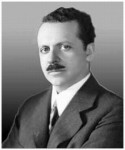“Propaganda assists in marketing new inventions. Propaganda, by repeatedly interpreting new scientific ideas and inventions to the public, has made the public more receptive. Propaganda is accustoming the public to change and progress.” ~E Bernays

Who decides what is and isn’t important? Who creates the demand for a particular product or service? What is the public’s role in this process? In Chapter 10 of Edward Bernays’ seminal text ‘Propaganda’, the “Father of PR’ outlines his contention that the mechanism of propaganda must be used to ‘accustom the public to change and progress.” In a short but insightful chapter, Bernays states that propaganda helps to establish what is beautiful, valuable, and desirable, specifically using the marketing of Art galleries as his example.
Although on the surface it may be ludicrous to suggest that contemporary art is a hoax, sold to us as being beautiful and revolutionary through the mechanism of propaganda, consider what our author Edward Bernays accomplished in terms of establishing the idea that the presence of a piano was essential in a modern home.
So what is art? Who defines it? Who controls it? To find out more, click here to download this podcast.
Chapter 10 Transcript – “Art And Science”
In the education of the American public toward greater art appreciation, propaganda plays an important part. When art galleries seek to launch the canvases of an artist they should create public acceptance for his works. To increase public appreciation a deliberate propagandizing effort must be made.
In art as in politics the minority rules, but it can rule only by going out to meet the public on its own ground, by understanding the anatomy of public opinion and utilizing it.
In applied and commercial art, propaganda makes greater opportunities for the artist than ever before. This arises from the fact that mass production reaches an impasse when it competes on a price basis only. It must, therefore, in a large number of fields create a field of competition based on esthetic values. Business of many types capitalizes the esthetic sense to increase markets and profits. Which is only another way of saying that the artist has the opportunity of collaborating with industry in such a way as to improve the public taste, injecting beautiful instead of ugly motifs into the articles of common use, and, furthermore, securing recognition and money for himself.
Propaganda can play a part in pointing out what is and what is not beautiful, and business can definitely help in this way to raise the level of American culture. In this process propaganda will naturally make use of the authority of group leaders whose taste and opinion are recognized.
The public must be interested by means of associational values and dramatic incidents. New inspiration, which to the artist may be a very technical and abstract kind of beauty, must be made vital to the public by association with values which it recognizes and responds to.
For instance, in the manufacture of American silk, markets are developed by going to Paris for inspiration. Paris can give American silk a stamp of authority which will aid it to achieve definite position in the United States.
The following clipping from the New York Times of February 16, 1925, tells the story from an actual incident of this sort:
“Copyright, 1925, by THE NEW YORK TIMES COMPANY—Special Cable to THE NEW YORK TIMES.
“PARIS, Feb. 15.—For the first time in history, American art materials are to be exhibited in the Decorative Arts Section of the Louvre Museum.
“The exposition opening on May 26th with the Minister of Fine Arts, Paul Leon, acting as patron, will include silks from Cheney Brothers, South Manchester and New York, the designs of which were based on the inspiration of Edgar Brandt, famous French iron worker, the modern Bellini, who makes wonderful art works from iron.
“M. Brandt designed and made the monumental iron doors of the Verdun war memorial. He has been asked to assist and participate in this exposition, which will show France the accomplishments of American industrial art.
“Thirty designs inspired by Edgar Brandt’s work are embodied in 2,500 yards of printed silks, tinsels and cut velvets in a hundred colors. . . .
“These ‘prints ferronnieres’ are the first textiles to show the influence of the modern master, M. Brandt. The silken fabrics possess a striking composition, showing characteristic Brandt motifs which were embodied in the tracery of large designs by the Cheney artists who succeeded in translating the iron into silk, a task which might appear almost impossible. The strength and brilliancy of the original design is enhanced by the beauty and warmth of color.”
The result of this ceremony was that prominent department stores in New York, Chicago and other cities asked to have this exhibition. They tried to mold the public taste in conformity with the idea which had the approval of Paris. The silks of Cheney Brothers—a commercial product produced in quantity—gained a place in public esteem by being associated with the work of a recognized artist and with a great art museum.
The same can be said of almost any commercial product susceptible of beautiful design. There are few products in daily use, whether furniture, clothes, lamps, posters, commercial labels, book jackets, pocketbooks or bathtubs which are not subject to the laws of good taste.
In America, whole departments of production are being changed through propaganda to fill an economic as well as an esthetic need. Manufacture is being modified to conform to the economic need to satisfy the public demand for more beauty. A piano manufacturer recently engaged artists to design modernist pianos. This was not done because there existed a widespread demand for modernist pianos. Indeed, the manufacturer probably expected to sell few. But in order to draw attention to pianos one must have something more than a piano. People at tea parties will not talk about pianos; but they may talk about the new modernist piano.
When Secretary Hoover, three years ago, was asked to appoint a commission to the Paris Exposition of Decorative Arts, he did so. As Associate Commissioner I assisted in the organizing of the group of important business leaders in the industrial art field who went to Paris as delegates to visit and report on the Exposition. The propaganda carried on for the aims and purposes of the Commission undoubtedly had a widespread effect on the attitude of Americans towards art in industry; it was only a few years later that the modern art movement penetrated all fields of industry.
Department stores took it up. R. H. Macy & Company held an Art-in-Trades Exposition, in which the Metropolitan Museum of Art collaborated as adviser. Lord & Taylor sponsored a Modern Arts Exposition, with foreign exhibitors. These stores, coming closely in touch with the life of the people, performed a propagandizing function in bringing to the people the best in art as it related to these industries. The Museum at the same time was alive to the importance of making contact with the public mind, by utilizing the department store to increase art appreciation.
Of all art institutions the museum suffers most from the lack of effective propaganda. Most present-day museums have the reputation of being morgues or sanctuaries, whereas they should be leaders and teachers in the esthetic life of the community. They have little vital relation to life.
The treasures of beauty in a museum need to be interpreted to the public, and this requires a propagandist. The housewife in a Bronx apartment doubtless feels little interest in an ancient Greek vase in the Metropolitan Museum. Yet an artist working with a pottery firm may adapt the design of this vase to a set of china and this china, priced low through quantity production, may find its way to that Bronx apartment, developing unconsciously, through its fine line and color, an appreciation of beauty.
Some American museums feel this responsibility. The Metropolitan Museum of Art of New York rightly prides itself on its million and a quarter of visitors in the year 1926; on its efforts to dramatize and make visual the civilizations which its various departments reveal; on its special lectures, its story hours, its loan collections of prints and photographs and lantern slides, its facilities offered to commercial firms in the field of applied art, on the outside lecturers who are invited to lecture in its auditorium and on the lectures given by its staff to outside organizations} and on the free chamber concerts given in the museum under the direction of David Mannes, which tend to dramatize the museum as a home of beauty. Yet that is not the whole of the problem.
It is not merely a question of making people come to the museum. It is also a question of making the museum, and the beauty which it houses, go to the people.
The museum’s accomplishments should not be evaluated merely in terms of the number of visitors. Its function is not merely to receive visitors, but to project iself and what it stands for in the community which it serves.
The museum can stand in its community for a definite esthetic standard which can, by the help of intelligent propaganda, permeate the daily lives of all its neighbors. Why should not a museum establish a museum council of art, to establish standards in home decoration, in architecture, and in commercial production? or a research board for applied arts? Why should not the museum, instead of merely preserving the art treasures which it possesses, quicken their meaning in terms which the general public understands?
A recent annual report of an art museum in one of the large cities of the United States, says:
“An underlying characteristic of an Art Museum like ours must be its attitude of conservatism, for after all its first duty is to treasure the great achievements of men in the arts and sciences.”
Is that true? Is not another important duty to interpret the models of beauty which it possesses?
If the duty of the museum is to be active it must study how best to make its message intelligible to the community which it serves. It must boldly assume esthetic leadership.
As in art, so in science, both pure and applied. Pure science was once guarded and fostered by learned societies and scientific associations. Now pure science finds support and encouragement also in industry. Many of the laboratories in which abstract research is being pursued are now connected with some large corporation, which is quite willing to devote hundreds of thousands of dollars to scientific study, for the sake of one golden invention or discovery which may emerge from it.
Big business of course gains heavily when the invention emerges. But at that very moment it assumes the responsibility of placing the new invention at the service of the public. It assumes also the responsibility of interpreting its meaning to the public.
The industrial interests can furnish to the schools, the colleges and the postgraduate university courses the exact truth concerning the scientific progress of our age. They not only can do so; they are under obligation to do so. Propaganda as an instrument of commercial competition has opened opportunities to the inventor and given great stimulus to the research scientist. In the last five or ten years, the successes of some of the larger corporations have been so outstanding that the whole field of science has received a tremendous impetus. The American Telephone and Telegraph Company, the Western Electric Company, the General Electric Company, the Westinghouse Electric Company and others have realized the importance of scientific research. They have also understood that their ideas must be made intelligible to the public to be fully successful. Television, broadcasting, loud speakers are utilized as propaganda aids.
Propaganda assists in marketing new inventions. Propaganda, by repeatedly interpreting new scientific ideas and inventions to the public, has made the public more receptive. Propaganda is accustoming the public to change and progress.
Further Reading
- Elliot, C. (2010). How to brand a disease – and sell a cure. CNN.com.
- Tye, L. (1998). The Father of Spin. Crown Publishers: New York, NY.
- Wallach, A. (1997). Art – is it art? Is it good? And who says so? The New York Times.
- Vogel, C. (1993). Art world is not amused by critique. The New York Times.
Materials
[youtube=http://youtu.be/_mHVy_hH8vc&w=500]
[youtube=http://youtu.be/eZn8QLsPvYI&w=500]
 Guy Evans is the Founder and Host of the Smells Like Human Spirit Podcast, which covers a wide variety of social and political issues. He also writes a regular column on former FBI translator Sibel Edmonds’ independent news website, BoilingFrogsPost.com.
Guy Evans is the Founder and Host of the Smells Like Human Spirit Podcast, which covers a wide variety of social and political issues. He also writes a regular column on former FBI translator Sibel Edmonds’ independent news website, BoilingFrogsPost.com.
Before getting into the world of independent media, he spent three years lecturing in the United Kingdom, playing international basketball, and running his own business. He has been featured in several academic publications for his student-focused lecturing and coaching approaches; notably a chapter in the internationally-distributed book ‘Athlete-Centered Coaching’ (Kidman, 2010). Mr. Evans lives with his wife (and three cats!) in Brooklyn, NY.
Source SmellsLikeHumanSpirit June 28 2014


 Guy Evans wraps up his series deconstructing the book ‘Propaganda’ authored by the ‘Father of Public Relations’ Edward Bernays. In the dramatic, perhaps prescient final paragraphs of the text, Bernays remained staunch in his belief that propaganda is necessary to quell the unconscious desires of the uninformed masses. In that sense, he echoed the sentiments of his famous uncle, Sigmund Freud, who suggested that human beings are in perpetual conflict due to the hidden inner forces that govern them.
Guy Evans wraps up his series deconstructing the book ‘Propaganda’ authored by the ‘Father of Public Relations’ Edward Bernays. In the dramatic, perhaps prescient final paragraphs of the text, Bernays remained staunch in his belief that propaganda is necessary to quell the unconscious desires of the uninformed masses. In that sense, he echoed the sentiments of his famous uncle, Sigmund Freud, who suggested that human beings are in perpetual conflict due to the hidden inner forces that govern them. Guy Evans is the Founder and Host of the Smells Like Human Spirit Podcast, which covers a wide variety of social and political issues. He also writes a regular column on former FBI translator Sibel Edmonds’ independent news website, BoilingFrogsPost.com.
Guy Evans is the Founder and Host of the Smells Like Human Spirit Podcast, which covers a wide variety of social and political issues. He also writes a regular column on former FBI translator Sibel Edmonds’ independent news website, BoilingFrogsPost.com.